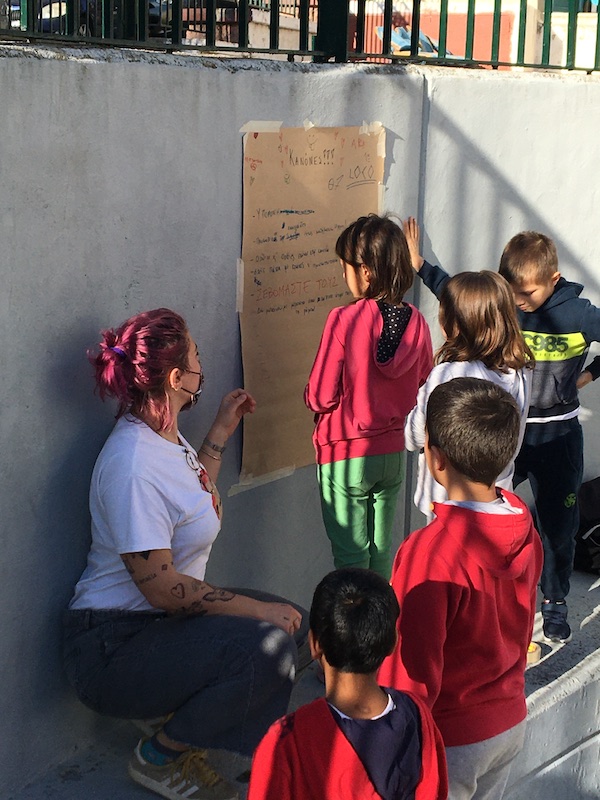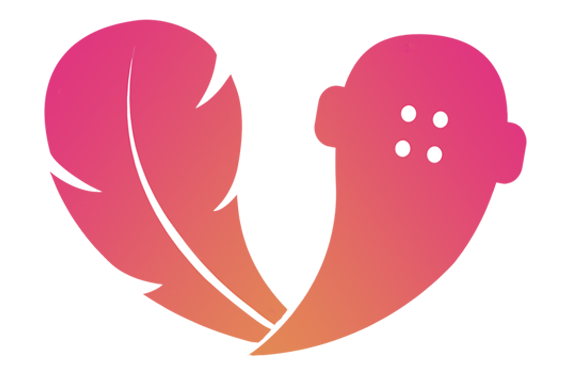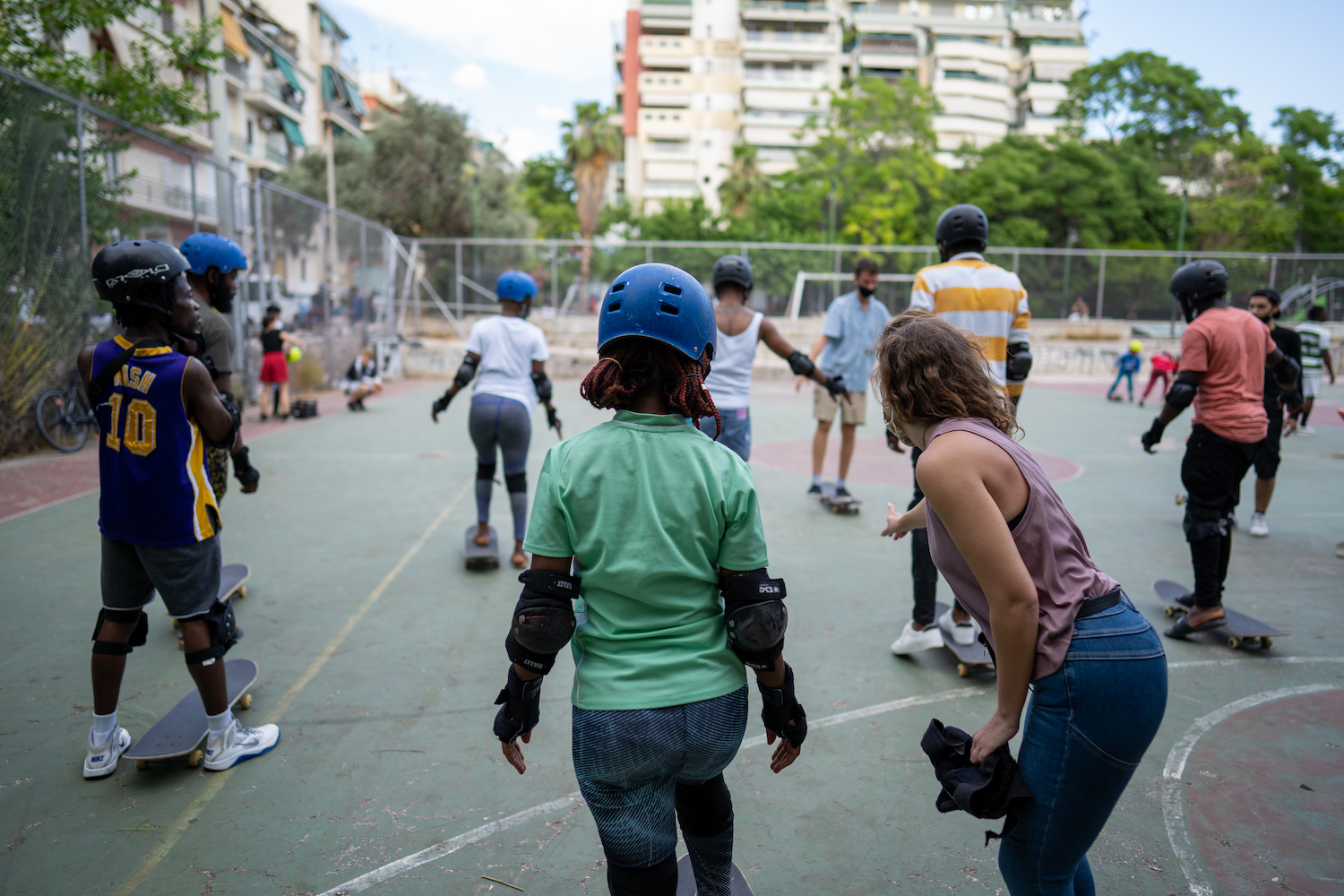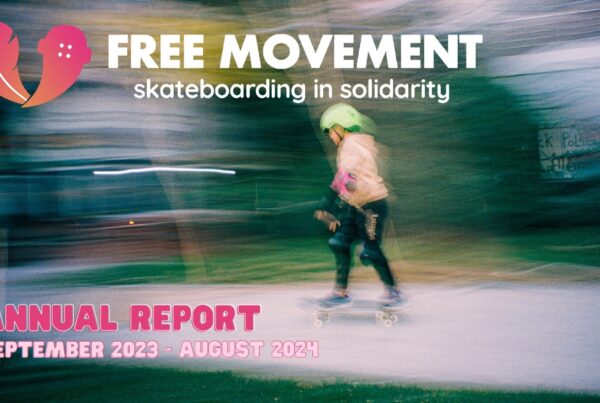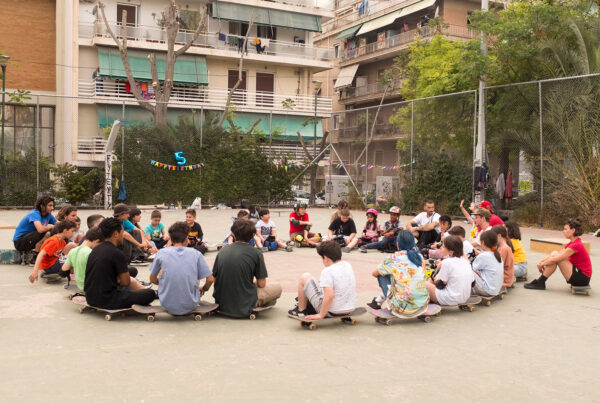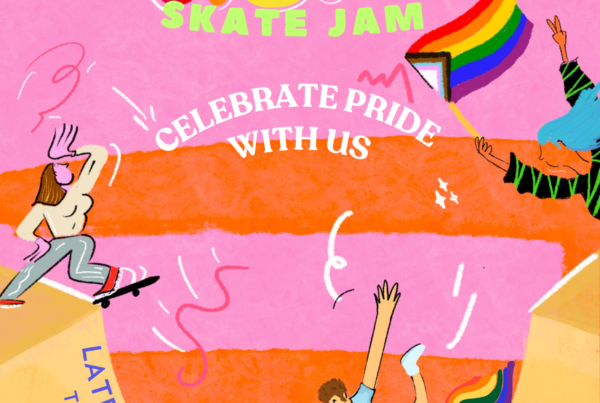Diversity and Inclusion, What Does it Mean to You?
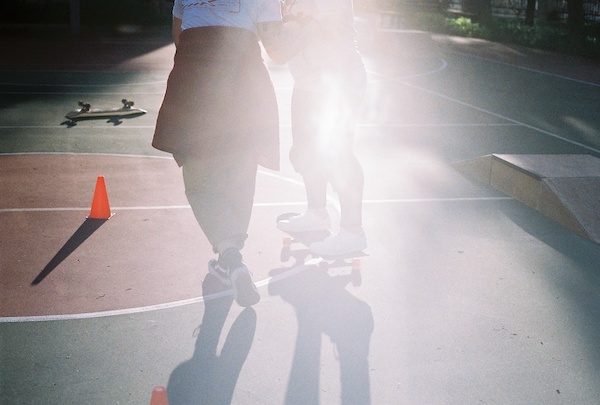
We hear the words diversity and inclusion increasingly these days, with many companies, community groups and charities having to switch to ‘more inclusive’ practices in order to keep up-to-date and give a positive impression. However, it seems like diversity and inclusion have almost become buzzwords which people easily throw around whilst not changing any of their actual practices. We don’t want this to be the case in the skateboarding world so let’s look at this from a slightly more critical view.
These days we are on a very positive path of increasing inclusivity within the skateboarding community worldwide, with many projects and initiatives set up to tackle the inequity of the skateboarding ‘traditions’. For the first time we see women on the front of magazines, skaters of colour being recognised and represented, media coverage outside of Europe and North America.
The thing to remember when considering social inclusion is that we are starting from a point of inequity. There are various physical, social and psychological barriers in place which highly compromise the inclusion of marginalised groups in skateboarding programs. Simply saying ‘this is a space for everyone’ is not enough—if you want your programs/skatepark/organisation to be inclusive then you have to make extra efforts to ensure this happens.
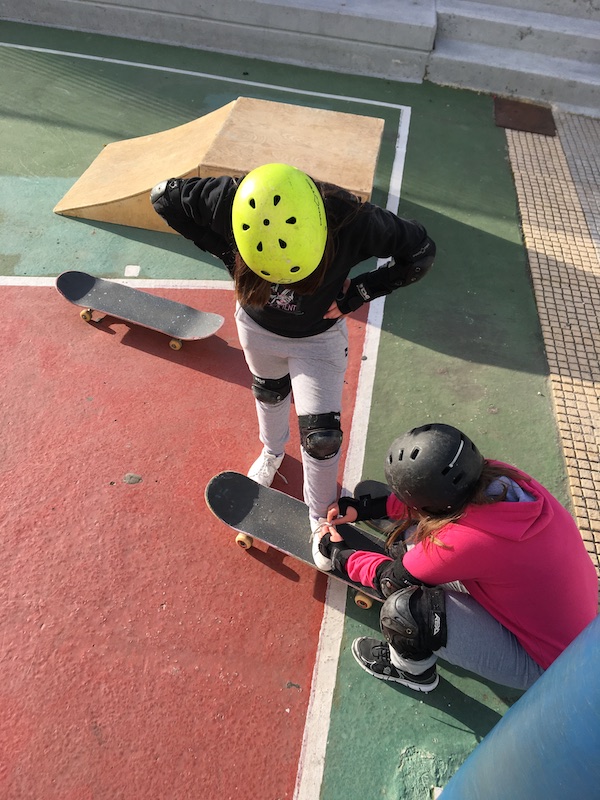
Advocating for equity starts with the recognition that there are underlying and often unacknowledged inequalities which give certain groups of people advantages over others. Let’s look at an example of one commonly excluded group: refugees, migrants and asylum seekers. Before even arriving at the program location they could be facing multiple barriers such as; hunger, tiredness, difficulty traveling (living in an isolated place/no transport links/no funds), family obligations, lacking confidence/self-esteem, language difficulties, bullying/harassment, and (especially for girls) feeling unsafe/scared/anxious going into an unknown space. All these factors work to accentuate their exclusion and limit their opportunities of participating in recreational and educational activities.
“Skateboarding gave us the space to want to be together – against what our parents wanted – to unite in our marginalisation.”
Dr. Neftalie Williams
As skateboarders, youth workers and coaches, we have the opportunity to not just rely on these terms “inclusion and diversity” whilst sitting back and watching the status quo continue. The beauty of skateboarding is that it gives you the tools to be able to affect meaningful change. As Dr. Neftalie Williams pointed out in the recent Goodpush Summit, the actual culture of diversity and inclusion was always present in skateboarding since the beginning. As kids they would all go against their parents’ wills to hang out with each other and go skate. Crossing the borders of race and class. So we ask ourselves: if there were skaters of colour and non-male skaters from the very beginning (which there were)—then why do we arrive so many years down the line with a struggle to change the culture that has left so many ‘non-traditional’ skaters feeling excluded? Media and representation are perhaps words on all of our lips.
Yes, seriously working towards tackling the systemic oppressions which limit inclusion of excluded groups takes much more time, energy and resources. However, these are often the groups of people who will benefit from your programs the most. A good first step is to review the existing conditions of the space you hold programs and the people you currently have in it. Is it accessible for people with disabilities and wheelchair users? Is it easy to get to via public transport? Is it a male-dominated space? Does your team reflect the diversity you want to see in your sessions? When it comes to the inclusion of marginalised groups, representation is really key.
“You cannot be what you cannot see…yeah, representation is all.”
Marie Mayassi – Melanin Skate Gals & Pals
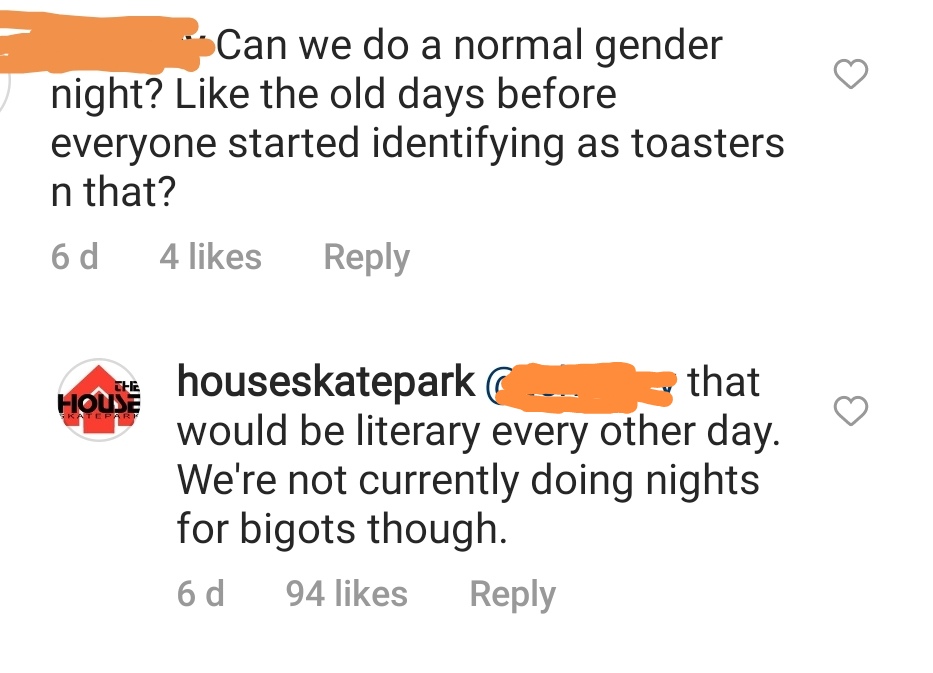
So to round off by circling back to the title and inspiration for this piece—a response on Instagram to a flyer that The House Skatepark in Sheffield posted for a ‘Minority Genders Night’ lead by New Wave Skate. We do not need a ‘normal gender night’ just as much as we don’t need an ‘able-bodied night’, a ‘whites-only night’ or an ‘heterosexuals-only night’. You are demonstrating exactly why exclusive, safe spaces are so vital for minority groups to feel comfortable and supported to show up and skate. It doesn’t mean that ‘traditional’ skaters are excluded as a result—they literally run these spaces every other night of the week.
Let’s work to close the gap and show minority groups that they are welcome in our skateboarding parks/programs/spots/groups!
Now let’s hear a few different perspectives from the skateboarding world…What does diversity and inclusion mean to you?
Dr. Indigo Willing, Academic & Co-Founder of Consent is Rad and We Skate QLD
“Skateboarding has always had a big mosaic of people involved. Yet as First Nations, People of Colour, LGBTIQ+ and Disability activists and other ‘non-traditional’ skaters have emphasised, not everyone has always been adequately recognised or had enough space to feel safe and included, let alone thrive. There needs to be more support to people who, in a range of roles, are deeply committed to activities to keep bringing in skaters from any ‘minority’ out of the periphery, and into spaces where we can all belong.
Diversity and inclusion can only have a chance through people doing more than just ‘shutting up and skating’. It’s clear we need to back the skaters, companies and groups who do more than ‘just skate’. We need to follow, engage with, fund, and talk more about the social change makers, story tellers, industry rebels, meet up organisers, skatepark advocates, adaptive skate spot designers, artists, writers, photographers, and video-makers who go all out to keep skating interesting, rebellious, less gate-kept and more fun. This includes people who have all skills levels, not just pro skaters and ‘cool guys’. We also need to document and highlight the presence of those most at risk of being erased and invisible, not just replicate energy drink competitions or big magazines.
As an Asian who grew up abroad, I also just want to give a shout out to so many exceptional ‘roll models’ out there, including Peggy Oki, Yulin Olliver, Jeffrey Cheung, Judi Oyama, Dani Abulhawa, Annie Dean-Ganek, J Wu, Kat Sy, Kim Woozy and Nam Chi Van, just to name just a few.”
David Lebuser – WCMX Wheelchair Skater, SIT’N’SKATE
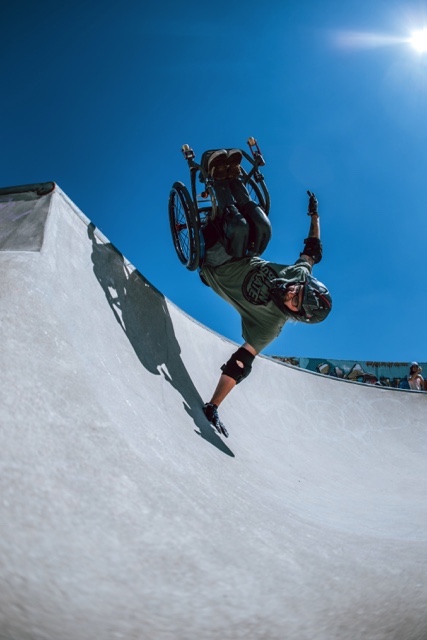
Photo credit: Pascal Lieleg
“Inclusion means that we give all the diverse people in society a chance to participate. This sounds doable right? Well this even sounds like it should be normal already, but it is not. I am a wheelchair user and since my disability has a more or less little impact on my body, even I face discrimination and exclusion almost daily. When I started skating in my wheelchair over 13 years ago I was kicked out of some skateparks because I don’t ride a proper and allowed sport device. Well most skaters chose for themselves if they ride a board, bike or else, but I just have my wheelchair and I still feel part of the skateboard scene.
Fortunate the skate scene opened up very fast, was mostly welcoming and supportive but still has a long way to go to get really inclusive. Another really hard example is that I can’t enter concert venues because I am in a wheelchair because I would be a safety threat, yes, for real, 2021 in Germany, there are still clubs which refuse to let me in, even if I would be able to get in and out by myself. Just think they would say people of color can’t enter or jewish people… I know it is not cool to use other marginalized groups, but you get what I mean, right? These are human made rules which say I am not allowed because of my disability. It is another thing when there is really a huge set of stairs which hold me out, it still sucks, and we still need to work on accessibility, but people throwing me out of clubs or skateparks where I already proofed that I can get in, be safe and I could participate, then this is pure Ableism in a very rude way.
So still in 2021 we have a long way to go and we need you as an Ally for our fight against Ableism. And if you are already fighting against racism, sexism, antisemitism, transphobia or any else, then think about this: People with disability are as diverse as the society, so ableism is a thing for people in every color, every gender and whatever they believe in. Show solidarity and let’s get as close as possible to the utopia of an 100% accessible and inclusive world, where everybody, and I mean EVERYBODY can participate – let’s do it step by step and push by push.”
Marquis Palmer, former FMS volunteer
“I’m very skeptical of the discourse surrounding ‘diversity and inclusion’ because it usually signifies an attempt to make an inherently exclusionary space slightly more inclusive without challenging that space’s fundamental exclusivity. For example, many American universities employ this ‘diversity and inclusion’ rhetoric and follow-up with initiatives that might help a few people that belong to historically marginalized identities — but do nothing to meaningfully help entire communities. This rhetoric and these initiatives are often deployed by universities that, for example, continue to invest in private prisons, depend on culturally skewed standardized testing, provide private loans or require loans to be taken out, and gentrify the low-income communities of color areas around which many of them are based — all actions that perpetuate structural inequality. In this way, ‘diversity and inclusion’ becomes, for them, a means by which to focus on individuals instead of addressing the larger role they play in perpetuating these drivers of structural inequality.”
